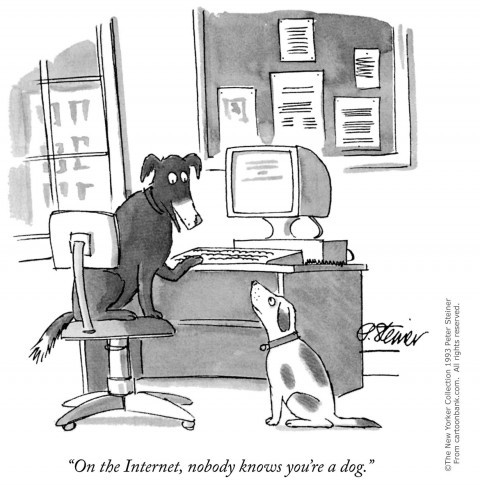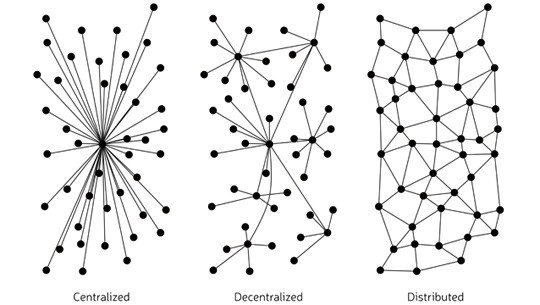Blockchain in 1,000 words
The invention of the Internet is a turning point of magnitude and relevance comparable to the printing press or the steam engine. Internet marked a before and after that has required transversal changes in all areas that include a significant sociological and philosophical. The Net has allowed a flattening of structures at all levels, in line with the dispersed nature of knowledge. This decentralization has favored a growth of productivity never seen before thanks to an environment with lower transaction costs, more decentralized, with more freedom for the economic agents and thus more generation of value. But these promises also had its limits.
The Digital World faced great challenges: trust, privacy, security or data control among others. User information, the raw material for the monetization of the bulk of the business in the network, most similar to the oil of the 21st century, was dispersed, uncontrolled, with little transparency, and in most cases outside the control of the interested party. In a famous cartoon, Peter Steiner joked with the problem of identity that was born with the Internet in the early 90s drawing a dog chatting on the Internet that says to another: “On the Internet, nobody knows you’re a dog.”
The economy was changing but, because of these limitations, perhaps not so much: we replaced old giants like IBM, Johnson & Johnson, Citibank, Bank of America or ExxonMobil, for the new Silicon Valley giants: Google, Apple, Facebook and Amazon becoming, in a relatively short period of time, the largest companies by market capitalization. The Internet, little by little, generated its own meta-structure that today generates not a few suspicions and misgivings about its opacity or the many asymmetries that have accumulated between these large data warehouses and final users.
The existence of economies of scale — “economies of network”, in the digital world — favored, as in the pre-Internet world, the existence of large corporations where the key was the possession and control of data and information.
It was still pending a revolution to take the Internet to the next level: an improvement that guarantees the control of the information by the user, the data, I insist, a new source of Capital in the 21st century, without the need for third parties. This would allow the user to become the true owner of their data which illuminates a new era of prosperity. Blockchain wants to be this reliable protocol that allows to consolidate a truly decentralized, more transparent, secure and open Internet.
A block-chain is a distributed database, not centralized at any point, dynamically encrypted, updated every 10 minutes with new data and inputs, so any new block that joins the System has to be validated in a decentralized way by the previous blocks. This dynamic element and its decentralization, allows this technology to be extremely efficient in storing increasingly data ordered in time and without the possibility of revision or modification. This provides great security, transparency and great control with respect to data flows by all users of the Blockchain network. Hence its great potential.
Each Blockchain is a networked database — something comparable to the Internet but more secure (you can thin on an enhance Internet) — with a specific purpose. With each new block, — transaction, update or data — , the chain is completely updated and validated in a decentralized way by all users, which makes it a tremendously safe storage tool. This decentralized verification offers previously unknown data control in the Internet world that allows us to transfer the physical world to the digital universe: in this way, for example, we can ensure that a Bitcoin, — so far the most successful Blockchain network—, is a specific user and nobody else. This is possible, as we said, thanks to the dynamic element, that heartbeat allows to approach the digital world to the reality and nature of dynamic market processes by definition.
Although it is still too early to venture to the extent of this new technology, as was the case with the Internet in the 1990s, we can say that Blockchain is ready to become the basis of the next great technological revolution.
Models of leadership and management, the great challenges
While Blockchain may be the answer to the bulk of the challenges posed today by the Internet — security, privacy, transparency and control — the challenges and barriers to its practical implementation are still of great magnitude. Proof of this is that, despite attempts and efforts, at the moment the only Blockchain network that has taken traction is that of Bitcoin’s a crytocurrency: a peer-to-peer (P2P) payment protocol, outlined by a series of people grouped under the pseudonym Satoshi Nakamoto. This is one of the applications with the greatest potential to change the economic order by favoring a denationalization of the money supply, nowadays in the hands of the central banks, by keeping a very similar (sought) parallelism with the classic gold standard system.
Apart from the technical, operational and regulatory difficulties, Blockchain’s expansion demands important changes in management models, public and private leadership, and even the need for a new citizen and democratic culture.
Technological change is faster than social or cultural change. The emergence of Uber, for instance, an aggregation platform rather than collaborative, have already encountered strong political and social barriers, what barriers will not find a technology that implies a decentralization of the economy of a magnitude twenty times greater? As happened with Internet 1.0, — the online commerce, social networks and collaborative economy — , this new Internet implies important changes in the way of doing business, sharing information, and generating wealth that, among many other things, enters in direct conflict with the old states; investors, consumers, businessmen and citizens in general are the ones more benefit from these new distributed models.
The need for a new culture, management models and values are the major challenges that new technologies present us today, if we want this new capabilities to open a new stage of prosperity for all.


Hi. I am a volunteer bot for @resteembot that upvoted you.
Your post was chosen at random, as part of the advertisment campaign for @resteembot.
@resteembot is meant to help minnows get noticed by re-steeming their posts
To use the bot, one must follow it for at least 3 hours, and then make a transaction where the memo is the url of the post.
If you want to learn more - read the introduction post of @resteembot.
If you want help spread the word - read the advertisment program post.
Steem ON!
Congratulations @luistorras! You have completed some achievement on Steemit and have been rewarded with new badge(s) :
Click on any badge to view your own Board of Honor on SteemitBoard.
For more information about SteemitBoard, click here
If you no longer want to receive notifications, reply to this comment with the word
STOP